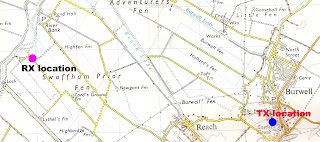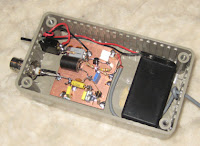When testing with utilities assisted earth mode in recent months I seemed to be getting weaker signals at 8.76kHz compared with my tests at 0.838kHz last summer. So, today I decided to go back and recheck results at a lower frequency at test sites 1.6, 2.6, 4.5 and 5.1km away from the 5W QRSS3 transmitter at home. Test locations were rural fenland roadsides, a National Trust car park and 2 roads in the next villages.
I used the same TX as at 8.76kHz, but divided down by a further x8 to 1.095kHz using the 4060 divider. The receiver was a horizontally orientated 30turn, 80cm across, series tuned loop into a low impedance MPF102 FET preamp with a drain circuit peaked at around 1.1kHz and emitter follower into PC running Spectran.
My initial test at 1.6km was a total failure - no signal visible at all in Spectran at 0.73Hz bandwidth. Then I realised that I had BOTH the garden earth electrodes in use at the TX (neither connected to pipes). A phone call to my wife and one wire was connected to the pipework in the house with the other still connected to the earth electrode at the bottom of the garden some 20m from the house. The signal then appeared at good strength.

Signals were received at all test locations indicated, but there was no signal visible (in QRSS3 bandwidths at least) when moving away from the roads into nearby fields or at some other test locations where pipes were absent (or plastic). At one location I rested the loop within 2m of one of the fenland water courses, but nothing was detected. The image attached is the signal at 4.5km, which is strong in 0.79Hz bandwidth. Even stronger signals are possible with more optimum positioning, but I keep having to move my loop to avoid it being crushed by oncoming farm tractors! I do get some odd looks too.
My conclusions from the tests to day are:
- This was definitely utilities assisted earth mode. The initial (accidental) test today with 2 earth electrodes not connected to water pipes failed.
- Signals are strong close to where the metal pipes are, but rapidly disappear where no (metal) pipes are close by.
- Signals at 1.095kHz are definitely stronger than at 8.76kHz in the 3-5km range.
There is one more test to do at some point that needs some assistance locally (I think within 10km to work). I want to try a long stable carrier test with someone looking in the very narrow bandwidths we've been using for the radiated tests recently. What I'm wondering is just how far from the pipes does an earth mode signal "leak"? Using Spectrum Lab with the very weak signal bandwidths like 0.4-2mHz, the weak remnants of a signal might just be visible some way from the "easy" utilities assisted coverage area.
The remaining tests I want to do still with earth mode are:
- River bank or sea coast test - just how far can one get?
- True earth mode in open country without any utilities assistance
- Earth mode at higher frequency e.g. around 70kHz, which I can manage with my present set-up. Based on recent OFCOM correspondence I believe such tests would be legal as long as there is no intentional radiated signal or interference to others.
This class of experiment is not in the same league as those being done by the radiating VLF DXers, but fun nonetheless, especially as anyone can do this sort of test without NoV or special permits needed.



















